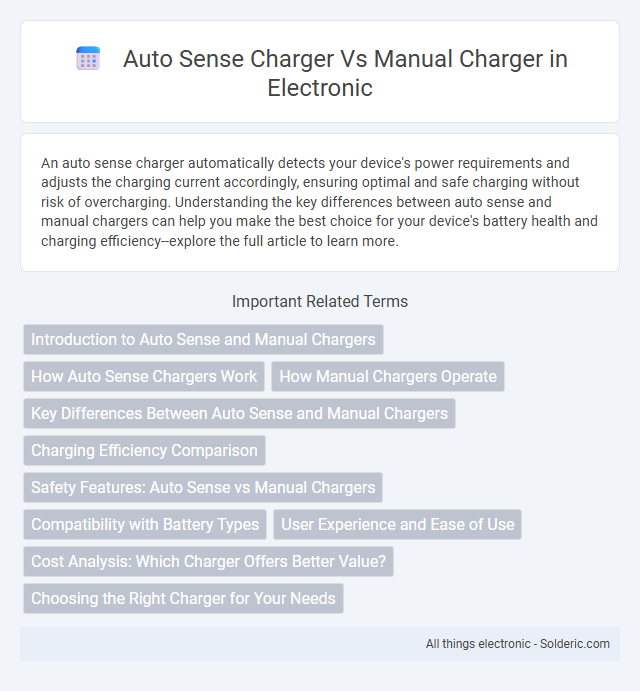An auto sense charger automatically detects your device's power requirements and adjusts the charging current accordingly, ensuring optimal and safe charging without risk of overcharging. Understanding the key differences between auto sense and manual chargers can help you make the best choice for your device's battery health and charging efficiency--explore the full article to learn more.
Comparison Table
| Feature | Auto Sense Charger | Manual Charger |
|---|---|---|
| Charging Mode | Automatically detects battery type and adjusts charging | Requires manual setting of charging parameters |
| Efficiency | Optimizes charging speed and power consumption | Dependent on user input; may lead to inefficiency |
| Safety | Built-in protection against overcharge, overheating | Safety depends on manual monitoring |
| User Convenience | Plug and charge - minimal user intervention | Requires user knowledge and adjustments |
| Compatibility | Supports multiple battery types and voltages | Limited to preset battery types |
| Price | Generally higher due to advanced features | Lower cost, basic functionality |
Introduction to Auto Sense and Manual Chargers
Auto Sense chargers automatically detect and adjust the charging current based on the device's battery capacity, enhancing safety and efficiency, whereas manual chargers require users to select the appropriate settings, increasing the risk of overcharging or undercharging. Auto Sense technology optimizes battery longevity and prevents damage by providing precise voltage and current regulation. Manual chargers are often less expensive but lack this intelligent control, making them suitable for basic or fewer charging needs.
How Auto Sense Chargers Work
Auto Sense chargers utilize built-in microchips and sensors to detect the connected device's battery type and current charge level, adjusting the power output accordingly to optimize charging speed and prevent overcharging. These chargers communicate with the device to deliver the precise amount of voltage and current required, enhancing battery lifespan and efficiency. In contrast to manual chargers, Auto Sense technology provides adaptive charging without the need for user input, ensuring a safer and more convenient charging experience.
How Manual Chargers Operate
Manual chargers operate by requiring users to adjust voltage and current settings based on the battery type and condition, often using analog controls such as knobs or switches. These chargers rely on the operator's knowledge to prevent overcharging or undercharging, as they do not automatically detect battery status or adjust output accordingly. Proper manual charging demands careful monitoring to ensure battery health and safety throughout the charging process.
Key Differences Between Auto Sense and Manual Chargers
Auto Sense chargers automatically detect and adjust the charging current to optimize battery life and prevent overcharging, while manual chargers require you to set the charging parameters manually. Auto Sense technology enhances safety and efficiency by providing adaptive voltage and current based on the battery's condition, unlike manual chargers that rely solely on user input, which may lead to improper charging. Your choice between these chargers affects overall battery health and charging convenience, with Auto Sense offering smarter, maintenance-free operation.
Charging Efficiency Comparison
Auto sense chargers optimize charging efficiency by automatically detecting battery type and adjusting voltage and current accordingly, reducing energy waste and prolonging battery life. Manual chargers rely on preset settings which may cause overcharging or undercharging, leading to lower energy efficiency and potential battery damage. Studies show auto sense technology can improve charging speed by up to 30% while minimizing heat generation compared to traditional manual chargers.
Safety Features: Auto Sense vs Manual Chargers
Auto sense chargers offer enhanced safety features by automatically detecting battery voltage and adjusting current flow to prevent overcharging and overheating, significantly reducing the risk of battery damage or fire. Manual chargers lack these intelligent detection systems, requiring constant user monitoring to avoid overcharging and potential hazards. Advanced auto sense technology incorporates short-circuit protection, temperature regulation, and reverse polarity safeguards, making them safer compared to traditional manual chargers.
Compatibility with Battery Types
Auto sense chargers detect battery chemistry and adjust charging parameters, ensuring optimal compatibility with lithium-ion, nickel-metal hydride (NiMH), lead-acid, and sealed lead-acid (SLA) batteries. Manual chargers require users to select the battery type, increasing the risk of improper charging and potential battery damage if settings are incorrect. Auto sense technology enhances safety and battery lifespan by precisely matching voltage and current to diverse battery chemistries.
User Experience and Ease of Use
Auto sense chargers enhance user experience by automatically detecting the connected device's power requirements, ensuring optimal charging without manual adjustments. Manual chargers require users to select the appropriate settings, which can lead to errors or slower charging if the wrong mode is chosen. The convenience and efficiency of auto sense chargers significantly improve ease of use, especially for users with multiple devices.
Cost Analysis: Which Charger Offers Better Value?
Auto sense chargers typically provide better value due to their ability to optimize charging based on device requirements, reducing energy waste and prolonging battery life, which leads to long-term cost savings. Manual chargers may have a lower upfront cost but often result in slower charging and potential overheating risks that could shorten device lifespan and increase replacement expenses. Choosing an auto sense charger ensures your investment supports efficient charging and durability, maximizing overall cost-effectiveness.
Choosing the Right Charger for Your Needs
Auto sense chargers automatically detect your device's power requirements to deliver the optimal current, preventing overcharging and enhancing battery lifespan. Manual chargers require you to select the appropriate output voltage and current, which may risk device damage if set incorrectly. Selecting an auto sense charger is ideal for versatile use with multiple devices, while manual chargers are suitable for users with specific, consistent charging needs.
Auto sense charger vs manual charger Infographic

 solderic.com
solderic.com